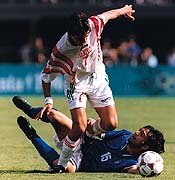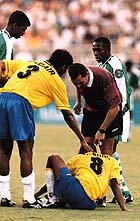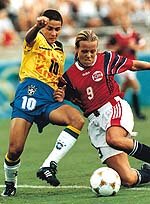-
A questionnaire was circulated to each team and a summary of the findings constitutes this report. Suggestions and comments are given at the end of this report.
-
Age range of the administrative staff (information from 12 men's and 6 women's teams)
20 to 30 years: 7
30 to 40 years: 14
40 to 50 years: 19
50 to 60 years: 13
over 60 years: -
Total: 53 persons
-
It is to be noted that 25% of this group is in the 50-60 year range. In preparing teams for major international competitions arrangements must be made to care for the players as well as the administrative accredited staff.

All of the delegations traveled to the USA with qualified medical personnel. And this proved essential since there were many minor injuries requiring quick and competent treatment at the touchline.
|
Doping control
-
Random doping controls were done on Wednesday, July 24, 1996 in Miami, Florida. During the semifinals and finals in Athens, Georgia, a total of 32 doping controls were performed on both the men's and women's teams.
-
For future competitions, a significant amount of attention must be directed to the prompt reporting and improved communications regarding the results of testing, be they negative or positive.
Accommodation, food, other services
-
Most of the men's and all of the women's teams were housed in hotels and/or the Olympic Villages. Four women's teams considered the rooms too small. The majority of the accommodation was located in the suburbs and was relatively close to training and game venues, with the exception of three teams which were at some distance from the game site.
-
Pollution from noise, smog and fans did not pose a problem. Security was reported as very good to excellent. One team felt that security at their training ground could have been better.
-
Service at hotels, the Olympic Village and the mini village was good to excellent. A few teams had private dining facilities reserved for them, while the remainder used open dining areas. Except for two teams that made separate menu selection, all the other teams utilized a buffet system.
-
Meeting rooms were available to all but two teams (women). Laundry service was available at the hotel or at laundromats and did not present a problem. Water availability was not difficult and could be had at the hotels and supermarkets.
-
Food quality and quantity were rated as good to very good. Some teams utilized a combination of local food with food from their home country. Three men's teams and one women's team brought their own chefs. The four basic food groups were available to all teams.

Brutal intervention to prevent an opponent making the most of his ball skills was, thankfully, little in evidence. Of course this does not mean all challenges were always entirely fair.
|
Medical aspects
Pre-competition preparation.
Medical testing before arrival in USA:
- Biochemical Assays, Blood gases, pH
- Blood, Urine, Stool analyses
- Serum ferritin
- Aerobics and anaerobic tests
- ECGs of officials, players
- Respiratory and cardiovascular exams
- Vision tests
- Pre-competition doping control tests
- Liver and renal function tests
- Nutritional assays
- Infections disease monitoring
Medical Testing done in USA
-
One team carried out physical examinations on its players. One women's team carried out ECG's and clinical exams on arrival in the USA.
Adaptation
-
Early arrival, 10 to 30 days before the start of the competition, was employed by many of teams in order to adapt to the local conditions and to overcome the effects of jet lag and long distance travel. Increased fluid intake, more rest, increased salt and lighter clothing were also utilised in the process of adaptation. No teams reported any significant difficulty in their adaptation.
Digestive problems
- 1 men's team - diarrhoea, colic and acid syndrome
- 1 women's team - 2 cases diarrhoea and 1 of constipation
-
There were no other reports of digestive upsets nor illnesses.
Chronic injuries on arrival in USA
Men's teams
- 1 team reported 5 sprain, 8 contusions and 1 laceration
-
1 team 3 chronic ankle sprains
Women's teams
- 1 team reported 4 achilles tendonitides
- 1 team with 10 injured players - shoulder, wrist, elbow, anckle, knee, patella.
- 1 team - 1 achilles tendonitis, 1 hamstring strain
-
1 team - 1 ankle sprain, 1 knee sprain
-
Noticeable in the above lists are the tendonitides of the achilles and the knee and ankle sprains. After treatment, only one male player and a female player in the chronic injuries group could not participate because of their injuries.
Injuries during competition

The referee's initial assessment of injuries; an area which will have to be taken into consideration in future referee training programmes.
|
Men's teams
- 2 knee sprains
- 1 ankle sprain
- 1 hand fracture
- 1 foot fracture
-
1 traumatic synovitis, patello-femoral
Women's teams
-
There were three ruptures of the anterior cruciate ligament necessitating immobilisation and later transfer to their respective countries for surgical management. There was also one rupture of ankle ligaments for which surgery was planned on return home. Ankle sprains numbered six. Other injuries were:
- 1 knee sprain
- 1 foot sprain, mild
- 1 shoulder subluxation
- 1 rectus abdominis muscle contusion
- 1 facial laceration
- 1 strain thigh muscles
- 1 strain, other muscle
- Water intoxication
-
(1 needed hospitalisation)
Medical Personnel
Men's teams (information from 12 teams)
- 6 Orthopedists / Sport Medicine
- 2 Rheumatologists / Traumatologists
- 2 Traumatologists
- 2 Traumatologists / Sport Medicine
- 2 General Practitioners / Sport Medicine / Traumatology
-
Two teams travelled with two medical doctors each. One team had no medical doctor. There were a total of 12 physiotherapists with football/sport medicine experience of 2 to 15 years. Two teams did not have a therapist. All teams expressed great satisfaction with the prompt, excellent, professional medical care and facilities available within the USA.
Women's teams (Information from 6 teams)
- 4 Orthopedists / Sport Medicine
- 1 Rheumatologist / Sport Medicine
- 2 General Practitioners / Sport Medicine
All teams had at least one medical practitioner
- 5 Therapists
- 1 Masseur
-
One team did not have a therapist. General satisfaction with medical back-up services and facilities as well as efficiency and promptness was expressed by all the teams.
Team Physical Performance
-
All teams were satisfied with the performance on and off field of the players, who adapted well to the heat, humidity, travel, food, lodging and demanding game schedules.

Portugal was one of the few teams badly affected by injury. Two of its players were unable to continue in the tournament and had to fly home early.
|
Comments, Suggestions
-
The following represents comments by the medical/paramedical personnel of the men's and women's teams:
- Play evening games, especially during hot and humid weather.
- Not enough time between games to facilitate recovery and prevent and/or minimise injury.
- Greater food variety to accommodate players from different countries.
- Doping control should be done for all games.
- There should be a pre - Olympic medical congress before the games covering medical aspects of football.
- Water should be freely available to players during games and referees should be made aware of this fact.
- Teams should be allowed to have more than
-
18 or 16 players. Eliminate over-age players who did not participate in the qualifying rounds.
Summary
- Mass sporting events in which teams (players and officials) travel from distant lands and cultures, and speak different languages and have different modes of operation and behaviour, provide challenges to the best prepared hosts. The Olympic Football Tournament Atlanta '96 was no different. Proper pre-event preparation served to facilitate an almost injury/illness free environment to the participating teams. The local and international organizations guaranteed an efficiency and delivery of medical / paramedical care second to none.





